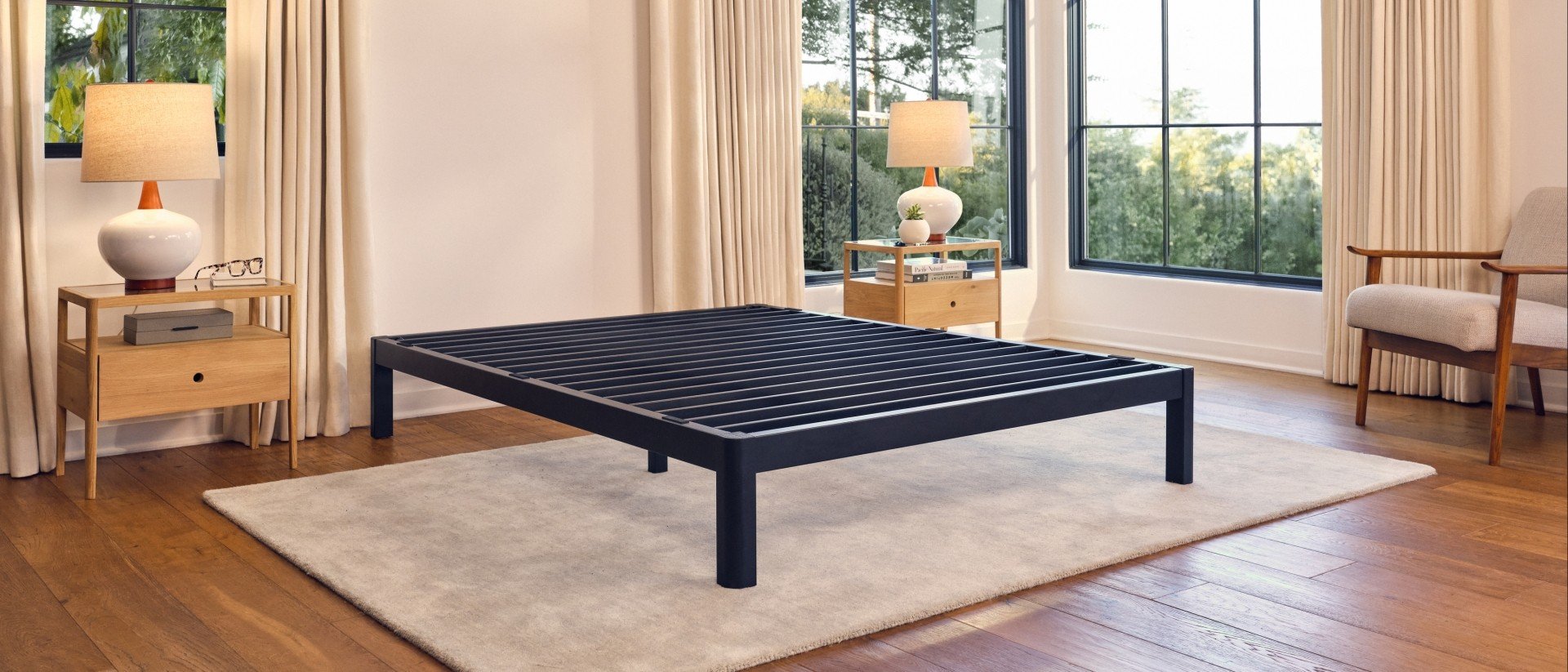
Bed Slats vs Box Springs: What You Need To Know
The primary difference between bed slats and box springs is their construction. Bed slats are planks of wood or metal that run across the top of the bed frame while box springs are metal or wooden boxes that contain spring coils. These two types of mattress foundations have their own unique properties and work well with specific kinds of bed materials.
Every mattress is only as comfortable as the base supporting it. If your foundation isn’t suitable with your mattress, the bed may sag overtime, causing improper alignment and tension in the body. To avoid sleep disturbances, opt for a mattress foundation that is sturdy, comfortable, and long-lasting.
Choosing between bed slats and box springs is often confusing for first-time shoppers, so read on for everything you need to know.
What Are Bed Slats?
Bed slats are wooden or metal planks that stretch horizontally across your bed frame. The slats typically have gaps 3 to 4 inches wide to provide optimal support for your mattress.
Bed slats pair well with most mattresses, though they may not be compatible with memory foam or innerspring mattresses due to lack of support.
For older, innerspring mattresses, bed slats may increase the firmness level of the mattress by providing a solid, sturdy foundation.
Advantages Of Using Bed Slats
A slatted base for your mattress offers many advantages, including the following:
- Even weight distribution
- Affordability
- Long lifespan
- Easy assembly
- Increased airflow due to gaps which may prevent night sweats and overheating for hot sleepers
- Lower profile foundation for sleepers who don’t require additional height
- Lightweight and easy-to-move frame
Disadvantages Of Using Bed Slats
Despite its benefits, a slatted foundation isn’t for everyone. Here are a few reasons why:
- The gaps may be too widely spaced and cause premature sagging
- Improper installation can cause shifting
- It may create a bed that is too close to the ground for taller sleepers
Are Bed Slats Bad For Mattresses?
Whether or not bed slats are bad for your mattress depends on the type of mattress. For instance, mattresses too heavy for wooden slats may cause breakage. Multi-layered hybrid and memory foam mattresses tend to be heavier, requiring the need for metal slats.
In addition, how you assemble your slats can affect your mattress. For instance, if you have a memory foam mattress, you shouldn’t build the slats more than 2.75 inches apart, or you’ll risk sagging.
What Is A Box Spring?
Box springs are metal or wooden boxes containing springs that absorb shock and distribute weight evenly. They are typically covered in fabric.
Traditional box springs were manufactured to push against the coils inside innerspring mattresses adding additional responsiveness and bounce.
Many old box springs no longer provide the same support of traditional constructions and are instead decorative, adding height to your mattress. Some modern box springs have an additional steel frame to make up for lost support.
A standard box spring is best for innerspring mattresses. You should avoid using box springs with other types of mattresses, but you may need a box spring or an alternative if your mattress is sagging or too low to the ground.
Like bed shams and ornate headboards, box springs are sometimes seen as "old-fashioned" compared with other types of mattress foundations, however, it is still recommended to use a box spring with innerspring mattresses for support/stability/benefit.
See: Mattress foundation and Sizes guide
Flat foundations are very similar to box springs, and make an ideal foundation for Purple mattresses. Box springs and flat foundations look the same externally, but internally are different: box springs have innersprings while flat foundations are composed of wood and/or steel.
Flat foundations and box springs both provide additional height for panel bed frames, which are bed frames with side/middle rails, space for a box spring and no slats. Compared to a platform bed, a panel bed requires additional structure to support your mattress in the form of a box spring or flat foundation.
Advantages Of Using Box Springs
Despite being outdated, modern box springs do have some advantages, including the following:
- Added height for low-profile mattresses
- Slight bounce and responsiveness if purchasing traditional box springs with coils
- Support for people with mobility issues
Disadvantages Of Using Box Springs
While traditional box springs have undergone a significant makeover, they are not as widely compatible. Below are the primary cons of box springs:
- Not collapsible, making them difficult to move
- Provide very little support, especially without coils
- Can cause sagging and indentions in mattresses
- Are not compatible with some mattresses
Types Of Bed Slats
There are two primary types of bed slats. Wooden slats are lightweight and easy to install. Metal slats are typically more durable but not nearly as flexible as their wooden counterparts.
Bed Slats Dimensions
Below, you’ll find the average measurements of bed slats for different mattress types:
Twin: 38 inches
Twin XL: 38 inches
Full: 54 inches
Queen: 60 inches
King: 76 inches
Slats vs. Other Mattress Foundations
While bed slats are not uncommon, there are many alternatives to consider, including the following.
Bunkie Board
Bunkie boards are wood, particleboard, or plywood barriers 1 to 3 inches thick. They are best for bunk bed mattresses that need to be cognisant of height limitations. In addition, you can place a bunkie board between your mattress and bed frame to create a sturdier foundation.
Adjustable Base
Adjustable bed frames are mechanical structures that allow sleepers to raise the head or foot of their mattress. Unlike bed slats, they provide ample pressure relief and comfort. Purple adjustable bases are specially designed with programmed settings that help to reduce snoring and improve breathing.
In addition, they are highly customizable and can support dozens of add-ons like sleep trackers and temperature regulation.
For this array of sleep-improving benefits, adjustable bases are far more expensive than slats.
Platform Beds
Platform beds are compatible with any type of mattress and don’t require a box spring or foundation. Sometimes, platform beds come with headboards and footboards. These beds are suitable for sleepers who prefer low-profile structures and want additional wall space for storage or decoration. You can attach these frames directly to the wall.
Should I Use Metal Or Wood Slats?
Typically slats are included with your bed frame and it's unlikely you'll need to shop for replacement slats. When purchasing a bed frame, check for 2 things:
1. The weight capacity of the bed frame
2. The spacing of the slats to ensure they’re not spaced too far apart
Weight capacity is the sum of mattress weight plus weight of the sleepers on the mattress. Both materials at the proper weight and spacing should provide sufficient support. If the bed frame's weight rating isn’t rated high enough for your mattress weight, it may make creaking noises.
Bed Slats FAQs
Can you buy slats for a bed frame?
Yes, you can buy slats separately for your bed frame.
Do bed slats break easily?
Bed slats can break easily if you assemble them poorly or apply too much weight. When purchasing bed slats, you’ll want to review their weight limit.
Can you use plywood instead of bed slats?
Yes, you can replace bed slats with plywood. Hardwood is a better option due to its affordability and enhanced support.

